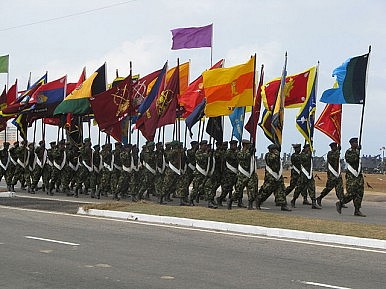What might explain the recent increase in defense spending?

Image Credit: Chamal Pathirana
Contrary to expectations that with the end of the civil war, Sri Lanka would reduce its spending on defense, Colombo has in fact increased its defense expenditure. Defense spending in 2009, the year the civil war ended with the comprehensive defeat of the Tamil Tigers, was Rs 175 billion ($1.2 billion). By 2011, this had risen to Rs 194 billion, and in 2013 it was Rs 235 billion. In late 2015, Colombo was looking to procure 18 to 24 new fighter aircraft to replace its obsolete fleet of MIG-21s by 2017. The budget allocation for defense in 2016 is Rs 307 billion.
Colombo’s 2009 victory over the Liberation Tigers of Tamil Eelam (LTTE) was achieved with heavy civilian casualties. Tens of thousands were killed and maimed. There was a purpose, to convince the survivors of the heavy price of war and remove the risk of any future uprising. Colombo was successful and knows it. Not only have thousands of Tamil Tiger soldiers been killed, but many thousands of former fighters and other young men and women have fled the country in fear of their lives Thousands of others are believed to be in government custody. Another uprising is highly unlikely.
Why then should Colombo spend a significant proportion of its GDP on defense, funds that could otherwise be spent on restoring the country’s war-ravaged economy? What exactly is the rationale for this exponential increase in defense spending?
If internal threats are non-existent, the threat must be external. From Colombo’s perspective, the major threat has always been its giant neighbour, India. It is a fear that has plagued Colombo since the late 1940s when Sri Lanka was about to be granted independence following Britain’s decision to relinquish India, the Jewel in the Crown. In 1947, Sri Lanka’s first Prime Minister, D. S. Senanayake, based the strategy of his country’s security on the assumption that the most likely threat to its independence would come from India. The British saw in these perceived fears a strategic advantage, linking the granting of independence to the island under a unitary constitution that gave the Sinhala majority enormous political power, while defense agreements gave Britain the use of naval and air bases in Trincomalee. The base in Trincomalee was of strategic significance to Britain, especially for securing links to Australia and New Zealand. D. S. Senanayake considered the unitary constitution as a safeguard against the Tamils federating with India, just as Ulster separated from the Irish Republic to federate with Britain, another of his fears and one that he shared with Lord Soulbury, the head of the commission appointed by the British to draft a constitution for the island.
Until the early 1980s, New Delhi sought to allay Sri Lanka’s fears through displays of generosity in bilateral relations. These included accepting in 1964 over half a million Tamils of Indian origin who had been disenfranchised by the Sri Lankan government in 1948; maintaining a cordial relationship with Sri Lanka despite the latter’s pro-Pakistan position during the Indo-Pakistani War of 1971; and conceding the disputed island of Kachatheevu to Sri Lanka in 1974.
By the early 1980s, however, India’s actions appeared to justify Sri Lanka’s suspicions when it armed and trained Tamil militants to exert pressure on Sri Lanka, which was showing clear signs of moving into the Western camp. These suspicions were only reinforced when India intervened directly in 1987 under the Indo-Sri Lanka Accord to deny the use of the Trincomalee Harbour to the U.S. and the setting up of a Voice of America broadcasting facility in Sri Lanka.
Although India provided Colombo with training and logistical support during Colombo’s final assault on the Tamil Tigers, this did not allay Colombo’s reservations about India. Colombo knows that New Delhi’s assistance to defeat the Tamil Tigers was to eliminate the organization that had assassinated Rajiv Gandhi, and was being made at the behest of Rajiv’s widow Sonia, who pledged full military support to Sri Lanka to achieve that goal.
Although Colombo’s war efforts had the support of New Delhi, it balanced that relationship by maintaining strong relationships with China and Pakistan. Without the help of the Chinese, who, in addition to their military aid, gave the Sri Lankan government diplomatic cover at the UN Security Council, Colombo could not have won the long-running civil war. Subsequently, when Colombo’s relationship with China grew stronger under President Mahinda Rajapaksa, Washington and New Delhi played a crucial role in bringing about a new government in Colombo. Sri Lanka’s new leader is decidedly pro-Western, but like all its predecessors, the new government has its reservations about New Delhi. A Crisis Group report in 2011 noted that with the LTTE gone, New Delhi’s capacity to influence Sri Lankan policy has been greatly reduced. Yet still Colombo mistrusts New Delhi. To many Sinhalese, India’s overt intervention in 1987, citing the plight of Tamils was a humiliating affair. At that time Sri Lanka’s armed forces were a fraction of their current strength, and were barely capable of dealing with the Tamil insurgency underway.
And so the victory over its internal foe, achieved with Chinese assistance, has provided Colombo with an opportunity to build up its forces as a deterrent against any future actions by what many Sinhalese perceive to be their external foe: India.
Ana Pararajasingham was Director-Programmes with the Centre for Just Peace and Democracy (CJPD) and is the author “Sri Lanka’s Endangered Peace Process and the Way Forward” (2007).
http://thediplomat.com/2015/12/colombos-military-build-up-a-strategy-of-deterrence/